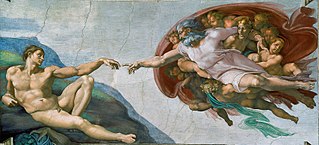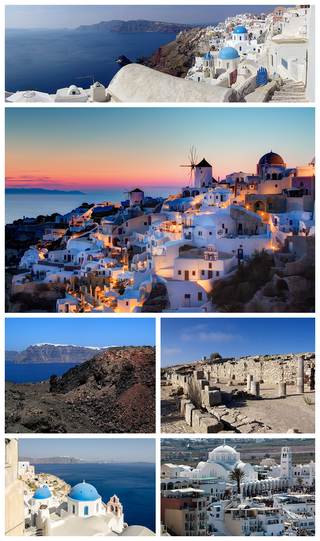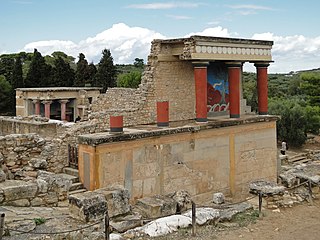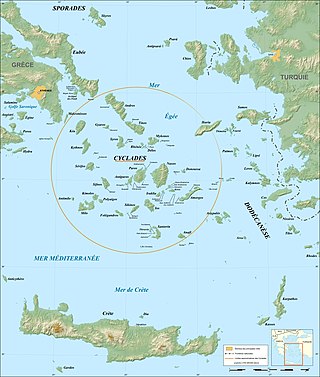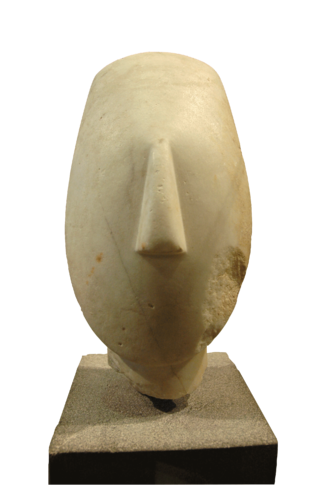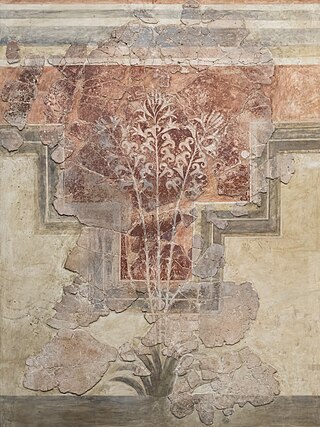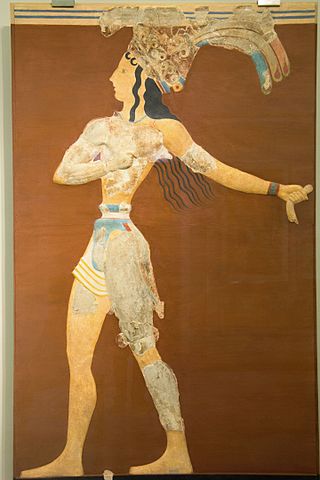List
| Thumb | Names | Site | Civilization | Period | Museum | Notes |
|---|---|---|---|---|---|---|
 | Antelopes Fresco | Akrotiri | Cycladic / Minoan | LC I LM IA | Athens | Outline of two antelopes symmetrically arranged. See: Wall Paintings of Thera |
| Blue Bird Fresco, Frieze, or Panel | Knossos | Minoan | LM IA | Heraklion | A bird, colored blue, beak closed, uncertain species, shown possibly perched or possibly rising on a downstroke, on or from rocks placed in a flower bed including wild roses, lilies of genus Pancratium, vetch, and other flowers. Part of the same band as the Monkeys Fresco in the House of the Frescos; hence, also called the Monkeys and Blue Birds Fresco. | |
 | Boar-hunt Fresco Wild boar-hunt fresco | Tiryns | Mycenaean | LH IIIB (13th century) | Athens | Three spotted hounds with collars harry a boar in a field of plants while its head is being pierced from in front by a spear held in a hand. |
| Boxers | Tylissos | Minoan | LM IA | Heraklion | Two fragments from one or two miniature frescos duplicating parts of a boxing scene shown on the Boxer Vase from Hagia Triada. A lower body is shown on one, a central body on the other. A kilted male figure in a boxing stance, legs bent, weight on the front leg, rear heel up, displays one arm extended fully with the fist drooping at the end of a snapping motion of the wrist. The Boxer Vase shows a helmeted figure with the off arm pulled back for counterbalance, martial-arts style. | |
 | Bull-Leaping Fresco, Taureador Fresco | Knossos | Minoan | MM IIIB | Heraklion | Composite scene of acrobatics over a galloping bull. The best of a series of similar scenes, the Taureador Frescos. |
| Cat and Pheasant | Hagia Triada | Minoan | LM I | Heraklion | A cat on the right side of some ivy-covered rocks stalks a pheasant with its back turned on the left. | |
| Cat and Pheasant | Knossos | Minoan | LM I | Heraklion | Two fragments, one depicting a spotted Cretan wild cat, with a white patch around the eye, and a second showing the overlapping tail feathers of a pheasant. | |
 | Charging bull and olive tree relief | Knossos | Minoan | MM IIIB | Heraklion | Half of a bull shown charging to right past a rock toward an olive tree. |
| Crocus Clumps Crocus Panel Crocus Frieze | Knossos | Minoan | LM IA | Heraklion | Band containing a repeated Crocus motif with four red flowers above a waveform double tricolor band: black, blue, white, black, blue, white. | |
 | Cup-bearer Fresco | Knossos | Minoan | LM I | Heraklion | Part of the Procession Fresco, but not one of the figures proceeding from left to right; i.e., not on the same wall. Kilted males bearing pottery in procession from right to left. Evidence exists for only the figure carrying the conical cup extending from head to midriff, often called a rhyton. |
 | Dancing Lady | Knossos | Minoan | LM IB | Heraklion | Non-acrobatic female upper torso and head, open bodice, tresses flying, arms up, probably dancing. |
 | Dolphin Fresco | Knossos | Minoan | LM I | Heraklion | A marine scene featuring a school of dolphins composed symmetrically with fish in the interstices and clusters of sponges around the periphery. |
 | Fisherman Fresco Fisherboy Fresco | Akrotiri | Cycladic / Minoan | LC I LM IA | Athens | Nude male figure holding two strings of small Mahi Mahi, one in each hand. See: Wall Paintings of Thera |
| Fisherman Fresco Fisherboy Fresco | Akrotiri | Cycladic / Minoan | LC I LM IA | Athens | Nude male figure holding one string of fish with two hands. See: Wall Paintings of Thera | |
 | Flying Fish Fresco or Panel | Phylakopi | Cycladic / Minoan | Phylakopi III, 1600–1400 LC I, LM IA | Athens | Two rows of flying fish. The top is fish in air with fins extended as wings. The bottom is fish leaving or entering water with fins folded. The interstices are filled with bubbles and spray. |
 | Griffin Fresco | Knossos | Minoan or Mycenaean | LM II | In situ | Griffins couchant in a background of rocks and lilies. |
 | Ladies in Blue | Knossos | Minoan | MM IIIB | Heraklion | Heads and upper torsos of three women with long tresses, headbands, flounced dresses of open bodice. Blue is the predominant color. |
 | Mycenaean Lady | Mycenae | Mycenaean | LH IIIB (13th century) | Athens | Head, torso of female with long tresses, headband, dress with full bodice, wearing necklaces, wristlets, holding up a necklace in the right hand. |
| Myrtle Shoots Myrtle Fresco Myrtle Frieze | Knossos | Minoan | LM IA | Heraklion | Several shoots with myrtle leaves rising from a band representing the ground. | |
 | Parisienne | Knossos | Minoan | LM III | Heraklion | Fragment from the Camp-Stool Fresco of a woman who seemed to the archaeologists to resemble a late 19th-century Parisian woman. |
| Partridge Fresco or Frieze | Knossos | Minoan | LM IB | Heraklion | Three distinct mural panels. Panel 1: two strutting partridges on the left face third on the right across uneven ground and a hoopoe perched in a bush. A partridge on the far right beyond a knoll flaps its wings, possibly crowing. Panel 2: three flapping partidges systematically arranged on uneven ground containing striated pebbles. Two more perch to the right. Panel 3: four partridges, the center dominated by a pair in chiasmus. | |
 | Priest-King Relief Fresco, Prince of the Lilies, Feather Prince | Knossos | Minoan | LM I | Heraklion | Procession Fresco figure. Male in a flounced kilt, headdress of uncertain nature, proceeding through a background possibly of lilies, reaching back to grasp possibly a tether. |
| Procession Fresco | Knossos | Minoan | LM I | Heraklion | Equivocal name: 536 original life-size figures in procession on the walls of the Corridor of Processions; 22 surviving figures of the procession; the 22 plus the Priest-king Relief Fresco, the Cup-bearer Fresco, and any and all fragments from the additional corridors leading to the south entrance and in the entrance. The 22 are divided into 3 related groups: A of 7 figures, B of 12 figures, and C of 3 figures. | |
| Procession Fresco Group A | Knossos | Minoan | LM I | Heraklion | Figures 1-7 of the procession Fresco. A pairwise procession of ladies with flounced skirts, bodices unknown, long tresses, facing to the right playing musical instruments: two sistra, one double pipe, and a 7-stringed lyre. The front pair raises its arms in the gesture of adulation. | |
| Procession Fresco Group B | Knossos | Minoan | LM I | Heraklion | Figures 8-19 of the procession Fresco. Groups of youths approach a central goddess from the right and left. She wears a flounced skirt, open bodice, headdress. Tresses extend to the ground. The head and lower body are in profile. Upper torso frontal. Hands are up, in each two double axes. On the left are 6 kilted males. The 4 nearest the goddess raise arms in adulation. Behind them 2 more bear pots. On the right a pair of kilted males, skirted females, raise arms in adulation. To the far right a kilted male faces the opposite direction. | |
| Procession Fresco Group C | Knossos | Minoan | LM I | Heraklion | Figures 20-22 of the procession Fresco. Three kilted youths bearing pottery in procession from left to right. Rocks in background. The weave of the kilts is detailed. | |
| Temple Fresco, Grandstand Fresco, Palace feast | Knossos | Minoan | LM I | Heraklion | A miniature fresco showing the facade of the Tripartite Shrine bordering on the Central Court of the palace at Knossos, surrounded by men in a red wash background and some women in an ivory background. Some ladies shown seated. Supporting pillars at sides possibly of a grandstand. The court is walled. |

